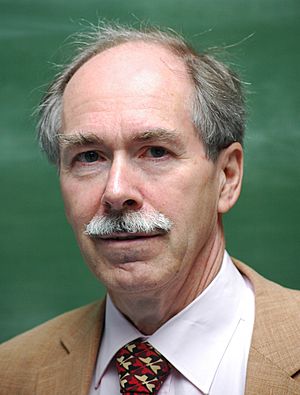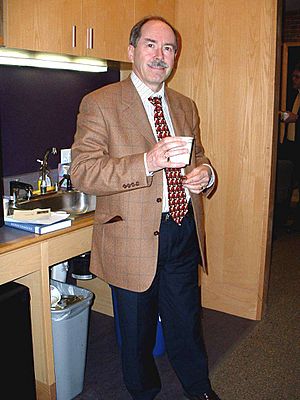Gerard 't Hooft facts for kids
Quick facts for kids
Gerard 't Hooft
|
|
|---|---|

't Hooft in November 2008
|
|
| Born | July 5, 1946 Den Helder, Netherlands
|
| Nationality | Dutch |
| Alma mater | Utrecht University |
| Known for | Quantum field theory Quantum gravity 't Hooft condition 't Hooft–Polyakov monopole 't Hooft symbol 't Hooft loop Feynman–'t Hooft gauge Black hole complementarity Minimal subtraction scheme Holographic principle Renormalization of Yang–Mills theory Dimensional regularization Renormalon 1/N expansion |
| Awards | Heineman Prize (1979) Wolf Prize (1981) Lorentz Medal (1986) Spinoza Prize (1995) Franklin Medal (1995) Nobel Prize in Physics (1999) High Energy and Particle Physics Prize (1999) Lomonosov Gold Medal (2010) Breakthrough Prize (2025) |
| Scientific career | |
| Fields | Theoretical physics |
| Institutions | Utrecht University |
| Doctoral advisor | Martinus J. G. Veltman |
| Doctoral students | Robbert Dijkgraaf Herman Verlinde Max Welling |
Gerardus "Gerard" 't Hooft (born July 5, 1946) is a Dutch theoretical physicist. He is a professor at Utrecht University in the Netherlands. In 1999, he won the Nobel Prize in Physics with his teacher, Martinus J. G. Veltman. They won for explaining how tiny particles interact through the "electroweak force."
Gerard 't Hooft's work focuses on understanding the rules of the universe. He studies things like black holes and quantum mechanics. He helped show that certain physics theories could be "fixed" to make sense. He also helped develop the holographic principle, which suggests our universe might be like a hologram.
Contents
About Gerard 't Hooft
His Early Life
Gerard 't Hooft was born in Den Helder, Netherlands, on July 5, 1946. He grew up in The Hague. He was the middle child in his family. His family had many smart people. His great-uncle, Frits Zernike, also won a Nobel Prize. His grandfather was a professor of zoology, and his uncle was a physics professor.
Gerard loved science from a young age. When he was in primary school, his teacher asked what he wanted to be. He said, "a man who knows everything."
After primary school, Gerard went to the Dalton Lyceum. This school used a special teaching method that he liked. He was very good at science and math. When he was 16, he won a silver medal in the Dutch Math Olympiad.
His Education
In 1964, after high school, 't Hooft started studying physics at Utrecht University. He chose Utrecht because his uncle taught there. His father wanted him to do more than just study. So, Gerard joined a student group. He was a coxswain for their rowing club. He also helped organize a science meeting for students.
During his studies, he decided to focus on elementary particles. These are the smallest building blocks of matter. For his master's thesis in 1968, he worked with Professor Martinus Veltman. Veltman studied a topic called Yang–Mills theory. At the time, many thought these theories had problems.
Gerard's first paper was published in 1971. In it, he showed how to make Yang–Mills theories work for particles without mass. This was a big step. Veltman was very excited because it solved a problem he had been working on.
They worked together closely. They created a new way to do calculations called "dimensional regularization." Soon, 't Hooft published another paper. This one showed how to make Yang–Mills theories work even for particles with mass. This work made them famous around the world. It also led to them winning the 1999 Nobel Prize in Physics.
These two papers became his PhD dissertation. He earned his PhD in 1972. That same year, he married Albertha A. Schik, who was a medical student.
His Career
After getting his PhD, 't Hooft went to CERN in Geneva. He continued to improve his methods for Yang–Mills theories with Veltman. He became interested in how these theories could explain the strong interaction. This is the force that holds atomic nuclei together.
His calculations showed that these theories could explain experiments about how particles scatter. This was a new idea at the time. He shared his findings at a small meeting in 1972. But he did not publish them right away. Later, other scientists, Hugh David Politzer, David Gross, and Frank Wilczek, found the same results. They won the 2004 Nobel Prize in Physics for it.
In 1974, 't Hooft returned to Utrecht as an assistant professor. He was a guest professor at Stanford and Harvard in 1976. His first daughter, Saskia Anne, was born in Boston. His second daughter, Ellen Marga, was born in 1978 after he came back to Utrecht. He became a full professor there.
From 2007 to 2016, 't Hooft was the editor-in-chief for Foundations of Physics. In 2011, Utrecht University made him a Distinguished Professor.
His Family Life
Gerard 't Hooft is married to Albertha Schik, also known as Betteke. They have two daughters together.
Awards and Recognition
In 1999, 't Hooft shared the Nobel Prize in Physics. He and his teacher, Veltman, were honored for their work on the "electroweak interactions." Before the Nobel Prize, he had already received many other awards.
In 1981, he won the Wolf Prize. This is one of the most important awards in physics after the Nobel Prize. In 1986, he received the Lorentz Medal. This medal is given every four years for important work in theoretical physics. In 1995, he was one of the first to get the Spinoza Prize. This is the highest award for scientists in the Netherlands. He also received a Franklin Medal that same year. In 2000, he got the Golden Plate Award. He was also given a Special Breakthrough Prize in 2025 for his work in physics.
Since his Nobel Prize, 't Hooft has received many more awards. He has also received honorary degrees and professorships. He was made a commander in the Order of the Netherlands Lion. He also became an officer in the French Legion of Honor. An asteroid, 9491 Thooft, was named after him. He even wrote a constitution for its future people!
He has been a member of the Royal Netherlands Academy of Arts and Sciences since 1982. He is also a member of many other science academies around the world. These include the French Académie des Sciences and the American United States National Academy of Sciences.
't Hooft appeared in a TV show called Through the Wormhole with Morgan Freeman.
His Research
Gerard 't Hooft's research can be grouped into three main areas. These are: "gauge theories in particle physics," "quantum gravity and black holes," and "basic ideas of quantum mechanics."
Gauge Theories and Particles
't Hooft is best known for his work on gauge theories. These theories help us understand how tiny particles interact. His PhD work showed that Yang–Mills theories could be "renormalized." This means they could be fixed to give meaningful results. He shared the 1999 Nobel Prize for this. He and Veltman developed "dimensional regularization" for this work.
After his PhD, he studied how gauge theories relate to the strong interaction. This force holds the parts of an atom's nucleus together. He looked at why we only see "color neutral" particles at low energies. This led him to discover that certain theories become simpler in a "large N limit." This idea has been important in understanding the connection between string theory and other physics theories.
He also studied "instanton" contributions. These are special solutions in Yang–Mills theories. His work showed that these contributions lead to new interactions between light particles. He found that breaking a certain symmetry in a theory could lead to "magnetic monopoles." These are like magnets with only one pole. These are called 't Hooft–Polyakov monopoles.
To help understand why particles are "confined," 't Hooft introduced "'t Hooft loops." These are like the magnetic opposite of "Wilson loops." Using these, he could sort different "phases" of the strong interaction. This helps create the "QCD phase diagram."
In 1986, he finally showed that instanton contributions solved a problem called the Adler–Bell–Jackiw anomaly. This was the topic of his master's thesis.
Quantum Gravity and Black Holes
When 't Hooft and Veltman were at CERN, they looked at how to apply their methods to gravity. They wanted to understand how to combine gravity with quantum mechanics. This is called "quantizing gravity." Their work helped lead to the discovery of "supergravity."
In the 1980s, 't Hooft studied gravity in three dimensions. He published a paper in 1984 that described how flat space behaves with point defects. He later showed how this model could be used to understand "Gott pairs." More recently, he suggested extending this model to four dimensions.
When Stephen Hawking discovered that black holes emit "Hawking radiation," it seemed to cause a problem. It looked like information might be lost forever in black holes. This is called the black hole information paradox. 't Hooft believed this problem must have a solution. He thought that a full theory of quantum gravity would not lose information.
He suggested that near a black hole, quantum fields could be described by a theory in a lower dimension. This idea led to the holographic principle. He and Leonard Susskind introduced this principle. It suggests that all the information about a 3D space might be stored on a 2D surface.
Basic Ideas of Quantum Mechanics
't Hooft has different ideas about how to understand quantum theory. He thinks there might be a hidden, predictable explanation behind quantum mechanics. He has created a model that suggests such a theory could exist. This theory would avoid problems with "Bell inequality" arguments. In 2016, he published a book about his ideas.
In 2025, he was quoted saying, "Quantum mechanics is the possibility that you can consider superpositions of states. That's really all there is to it." He also said, "And I'd argue that superpositions of states are not real."
Publications for Everyone
- Billings, Lee, "Quantum Physics Is Nonsense: Theoretical physicist Gerard 't Hooft reflects on the future" (interview with Gerard 't Hooft), Scientific American, vol. 333, no. 1 (July/August 2025), pp. 104–108.
See also
 In Spanish: Gerardus 't Hooft para niños
In Spanish: Gerardus 't Hooft para niños
- Asymptotic freedom
- Center vortex
- Hierarchy problem
- Pauli–Villars regularization
- Slavnov–Taylor identities
- Superdeterminism
- Mars One (Gerard 't Hooft supported this project)


